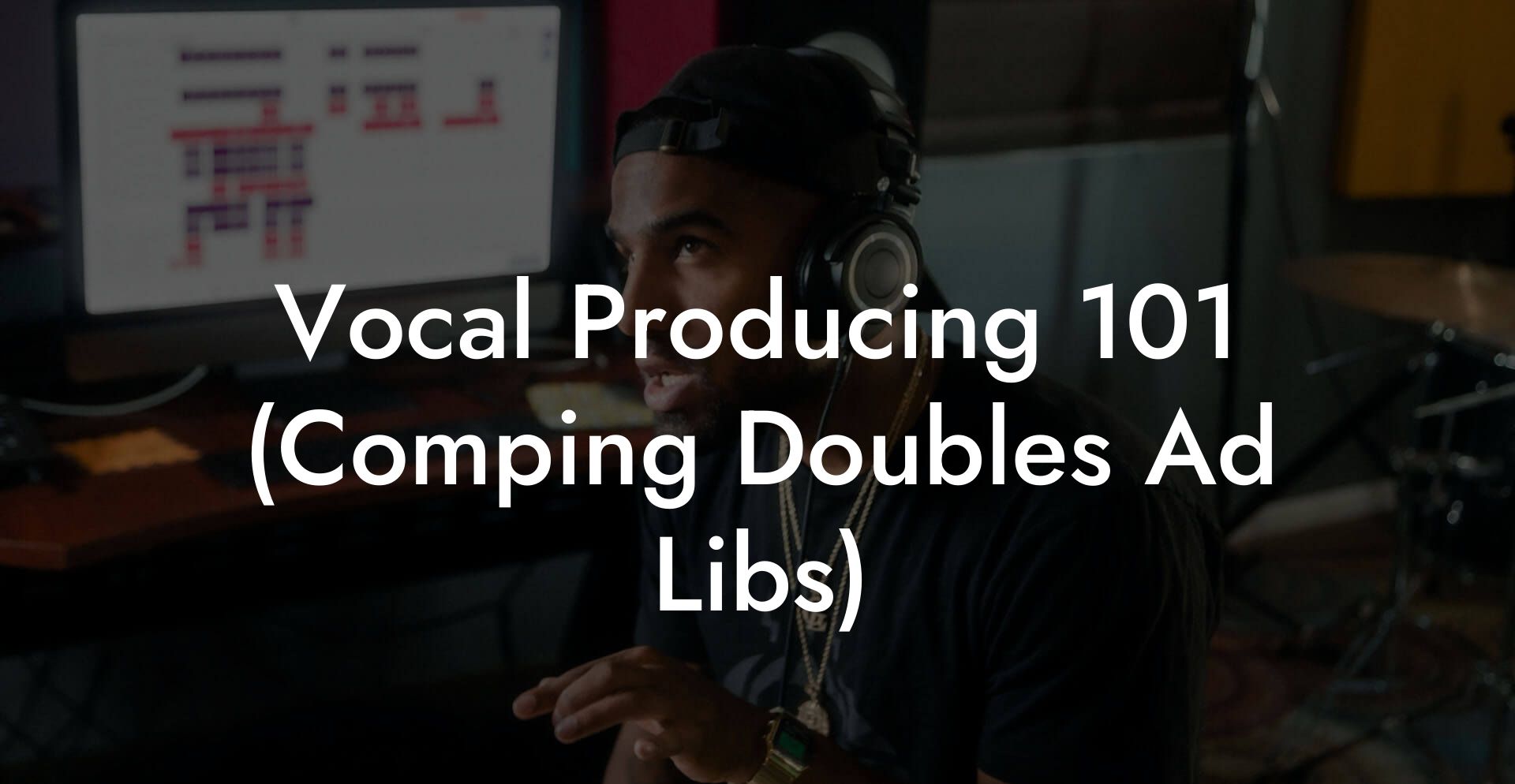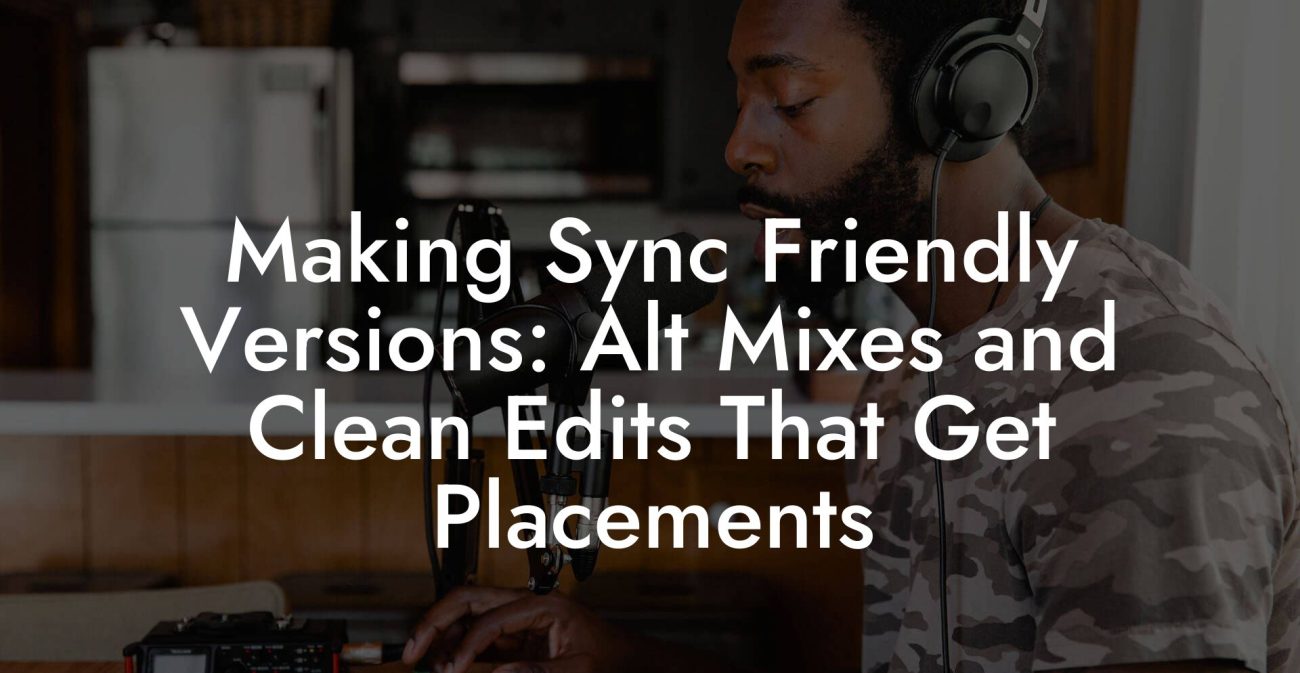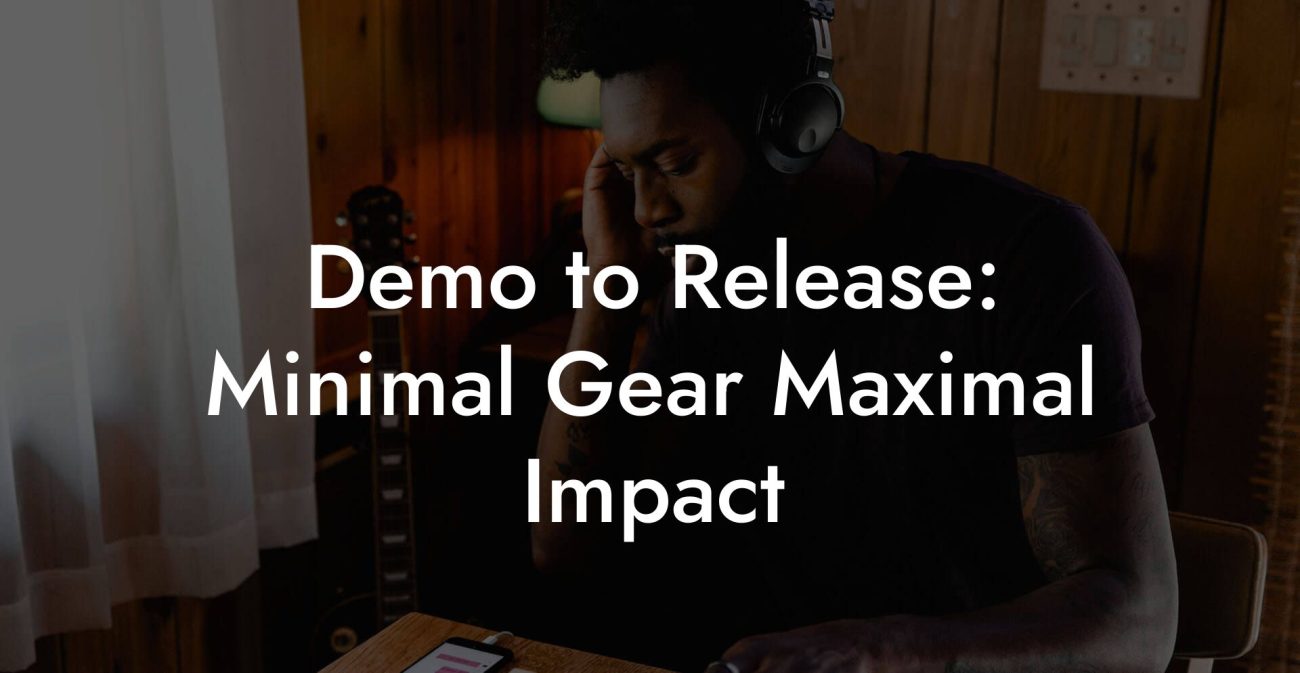Songwriting Advice
Vocal Producing 101 (Comping Doubles Ad Libs)

You do not need a stadium mic or a tantrum from the singer to make vocals sound massive. You need decisions. Vocal producing is the art of making records that sell playlists, not just leave open tabs. This guide walks you through comping, doubles, ad libs, tuning, stacking, editing, session organization, and the tiny tweaks that make a vocal feel alive and expensive. It is written for humans who sing in showers, living rooms, and rented basements. It is also for producers who overuse autotune like it is a condiment.
Quick Interruption: Ever wondered how huge artists end up fighting for their own songs? The answer is in the fine print. Learn the lines that protect you. Own your masters. Keep royalties. Keep playing shows without moving back in with Mom. Find out more →
Quick Links to Useful Sections
- What Vocal Producing Actually Means
- Key Terms, Explained Like Your Friend Who Only Uses Emojis
- Why Comping Matters More Than You Think
- Session Setup That Saves Hours Later
- Coaching the Vocal Performance
- Comping Workflow You Can Use Today
- Comping Tips That Sound Like Hacks But Are Real
- Double Tracking and Stacking Strategies
- When to use doubles
- Types of doubles
- Practical stacking recipe for a pop chorus
- Ad Libs That Actually Add Value
- Where to place ad libs
- Ad lib types
- Ad lib workflow
- Tuning Without Killing Soul
- Tools to know
- Tuning rules of thumb
- Cleaning Up: Breaths, Sibilance, and Noise
- Breath edits
- Sibilance and deessing
- Noise reduction
- Preparing Mix Ready Vocal Stems
- Genre Specific Tips
- Pop
- R and B
- Hip hop
- Indie
- Real Life Scenarios and Fixes
- The sick singer
- The eccentric vocalist who whispers into the mic
- The run that collapses
- The wash of too many doubles
- Session Templates and Shortcuts
- Communication and Credits
- Common Mistakes and How to Avoid Them
- Practical Exercises to Improve Your Vocal Producing
- Comping Drill
- Double Stacking Test
- Ad Lib Speed Runs
- Checklist Before You Send to Mix
- FAQ
- Action Plan You Can Do Tonight
We will cover the full map from session setup to mix ready stems. We will explain the jargon and give real life scenarios you will nod at because you did that exact thing at 2 a.m. We will include step by step workflows you can steal today. We will not waste your time with fluff. You will leave with a reproducible method to turn raw takes into songs that sound like money.
What Vocal Producing Actually Means
Vocal producing is the process of capturing and shaping a performance so it serves the song. It includes coaching the singer, choosing the best takes, comping those takes into a single master performance, layering doubles and harmonies, editing breaths and timing, tuning where needed, adding creative ad libs, and preparing clean stems for the mix.
Think of the vocal producer like a film editor who also directs the actor. You ask for emotions, you fix the mistakes, and you assemble the final story. You decide what needs to be perfect and what can be a little human because that little imperfection makes the record breathe.
Key Terms, Explained Like Your Friend Who Only Uses Emojis
- Comping , Short for compilation. You record multiple takes and then assemble the best words or phrases from each take into one seamless performance. Imagine cutting together the best bits of a comedy improv set into a single joke that slaps every time.
- Doubles , A second vocal recorded to follow the same melody and rhythm as the main lead. Doubles are used to fatten the vocal and give it presence. Double tracking means recording the same line twice and layering them together.
- Ad libs , Short improvised phrases or melodic lines usually placed around or after the chorus. They add personality and a live feel. They are the vocal equivalent of seasoning where too much or too little change the whole dish.
- Stacking , Multiple vocal layers combined to create a thick texture. Stacks can be exact doubles, wide doubles, harmonies, or textural whispers.
- Tuning , Adjusting pitch using software tools so notes sit where you want them. Tuning can be subtle body work or full on robotic effect depending on genre and vibe.
- Timing edits , Moving syllables or words earlier or later in the grid so they lock with the groove. Timing edits make the vocal and beat feel like they are holding hands.
- Crossfades , Smooth transitions between audio clips so you cannot hear the cut. Essential for clean comping.
- Sibilance , Harsh S and T sounds that can cut like glass. Deessing reduces sibilance.
- Stems , Grouped tracks exported for mixing. You might deliver a lead vocal stem, a doubles stem, and an ad libs stem. Stems keep your mix engineer from cursing into the void.
Why Comping Matters More Than You Think
A great comp is not a Frankenstein monster that pokes the listener. It is a live feeling built from multiple perfect tiny moments. Comping lets you cherry pick the emotional flicker from take three and the breath control from take seven and place them beside a phrase that was sung with complete conviction on take two. A bad comp sounds glued. A good comp sounds like one continuous breath.
Real life scenario. Your vocalist had the best day ever on take six. The runs were divine but the final note popped off key. Take eight has a perfect final note but the runs sound mechanical. You comp the runs from six and the final from eight and no one knows. Except your friend who always notices everything. You sip your green tea of victory and move on.
Session Setup That Saves Hours Later
If you treat a vocal session like chaos you will spend the mix doing CPR. Here is a checklist that keeps your life tidy.
- Label every track with the take number and the phrase if possible. Example: Lead Take 03 Verse 1.
- Use markers for verse chorus bridge. This saves you from listening to the same chorus four hundred times.
- Record with a small amount of compression if the vocalist likes it. But always have a clean dry channel too. The clean channel is your safety net if compression tastes change later.
- Record doubles on separate tracks. Do not bury them under the lead. You will thank me.
- Use consistent microphone technique and distance. If the singer moves around, track it with a room mic for texture. Room mics can save dry performances from sounding hygge empty.
- Keep a scratch vocal or reference vocal so the singer remembers the feel. Label it as reference and do not comp it into the master unless you want to ruin the surprise.
Coaching the Vocal Performance
As a vocal producer you are part therapist and part drill sergeant. You get the best takes by combining clear direction with a relaxed vibe. Here are simple coaching lines that actually work and do not sound like sad radio acting class advice.
- Want more intimacy? Ask the singer to pretend they are whispering into one person's ear across a crowded bar.
- Want power without strain? Ask them to sing the line like they are talking bold to their mirror at 6 a.m.
- Want emotion? Ask them to set a tiny image. Not the whole movie. Something like a message unsent in their outbox.
- For runs and ad libs, have the singer record a bunch of wild passes. Keep the ones that are human and surprising. Humans like tiny imperfections.
Comping Workflow You Can Use Today
This is a practical method used by pros that ships fast and scales to any session. It assumes you have multiple takes recorded and your DAW supports basic clip editing and crossfades.
- Listen through quickly. Do one fast pass and mark the moments that pop. These are usually emotional peaks or perfect runs.
- Make a rough comp. Place your favorite full takes in the track order so you get a playable single pass of the song. This is a starting map.
- Phrase level comping. Break the rough comp into phrases and choose the best phrase for each slot. Use crossfades of 8 to 12 milliseconds to avoid clicks. Crossfades should be as long as noise allows. If you hear a weird phase artifact, shorten or lengthen until it disappears.
- Check breaths and consonants. Sometimes the note is perfect but the consonant attack sounds odd. Replace only the consonant or the breath from another take if needed. Keep the energy intact.
- Timing alignment. Move tiny pieces to lock with the pocket. Use nudges of milliseconds. If you move too much you risk unnatural artifacts.
- List listens. Listen on headphones and monitors. Use a few different playback systems to verify naturalness.
- Export a safety comp. Export the comp to a single stereo file labeled clearly. Keep the session with all versions in case someone asks for a different vibe later.
Comping Tips That Sound Like Hacks But Are Real
- If a phrase needs energy and none of the takes have it, try copying the ending consonant from a more energetic take and placing it in subtly. The ear accepts it if the envelope and ambience match.
- When comping long sustains, avoid chopping mid vowel. Instead pick the best sustain and trim starts elsewhere.
- Use a small fade in when bringing in consonant heavy words from another take to avoid clicks and phase issues.
- If you hear flanging or weird phase, try inverting phase on one of the takes for testing. Often the problem is mic proximity variance rather than pitch.
Double Tracking and Stacking Strategies
Doubles are the difference between intimate and cinematic. Use them like seasoning. Too little and the vocal is thin. Too much and it becomes a choir with a midlife crisis.
When to use doubles
- Use doubles on choruses to add weight.
- Use doubles sparsely on verses to maintain intimacy but support certain lines.
- Use doubles in bridges when you want a lift without changing chord structure.
Types of doubles
- Exact doubles. The singer sings the same melody as the lead. Use tight panning and slight timing differences to create width. Exact doubles give power.
- Octave doubles. Sing the same melody an octave above or below. This creates harmonic interest without changing the rhythm.
- Wide doubles. The singer slightly changes timing or vowel shape. Pan these left and right for a stereo spread. They make the chorus feel huge.
- Textural doubles. Whispered or lightly sung layers that live behind the lead. These add air.
Practical stacking recipe for a pop chorus
- Lead vocal center.
- Double 1 exact, slightly delayed by 8 to 12 milliseconds, panned 15 left.
- Double 2 exact, slightly delayed by 12 to 18 milliseconds, panned 15 right.
- Wide double left, sung with slightly different vowels, panned 50 left and lower in level by 3 to 6 dB.
- Wide double right, mirrored of the left wide double. Lower in level and consider a subtle chorus or doubler effect only on the wide doubles for shimmer.
- Optional octave below under the chorus to add low body. Low vocals can muddy if the arrangement is busy. High pass around 120 Hz on the octave below.
Ad Libs That Actually Add Value
Ad libs are the pop star wink. They can lift the final chorus and give the track personality. Use them with intention.
Where to place ad libs
- At the ends of chorus lines where they can decorate the hook.
- Between chorus lines during repeats to keep repetition fresh.
- In the outro to leave listeners with a memorable phrase.
Ad lib types
- Melodic ad libs. Short melodic phrases that play around the chord tones.
- Rhythmic ad libs. Vocal percussive sounds or chopped phrases that become rhythmic elements.
- Textual ad libs. Syllables or words used for texture like ohs and yeahs.
Ad lib workflow
- Record many audacious passes. Tell the singer to act like they are on stage finishing the song. The best ad libs are performed not calculated.
- Trim the ad lib to remove noisy breaths and unwanted consonant attacks.
- Place ad libs on separate tracks, not buried under the main vocal. Buyers of stems will thank you.
- Automate levels so the ad lib sits above the lead at moments of emotional pay off and sits back during dense parts of the mix.
Tuning Without Killing Soul
Tuning is a tool not a dictator. The goal is to correct pitch issues while preserving expression. Over tuning sucks the life out of a performance. Use a scalpel not a jackhammer.
Tools to know
- Autotune , A brand name that often refers to real time pitch correction. You can use it as an effect or as a corrective tool. When used as an effect, intentionally set a fast response time. When used for correction, set it to a slower response so transitions remain natural.
- Melodyne , A pitch editing tool that lets you move individual notes, change vibrato, and reshape timing. Melodyne is more surgical and often keeps naturalness better than harsh real time correction.
- Manual editing , Sometimes the best move is to find another take with a better performance and comp that phrase in. Use tuning as a last resort for small issues.
Tuning rules of thumb
- Only tune notes that are noticeably off. If a note is slightly flat or sharp but feels emotionally correct, leave it alone.
- Avoid tuning runs where the singer intentionally slides between notes unless you want the robotic effect.
- If you must tune a sustain with heavy vibrato, copy the sustains into Melodyne and flatten the center pitch rather than chopping vibrato out entirely. This keeps life in the note.
- When in doubt, compare tuned and untuned versions in context of the track rather than soloing the vocal.
Cleaning Up: Breaths, Sibilance, and Noise
Cleaning is the part of vocal producing that no one wants to notice. If you do it well, no one will notice.
Breath edits
- Keep breaths that feel natural. Delete breaths that interrupt the groove or sound louder than the voice.
- Replace large breaths with smaller ones from other takes if you need the inhale but want it quieter.
- Use fade ins on breaths to remove clicks.
Sibilance and deessing
Sibilance is the S attack that pierces a cheap pair of earbuds. Use a deesser to tame sibilance. Deessers work by detecting bright consonants and applying compression or EQ only to that band.
- Apply deessing in subtle amounts. Over deessing makes the vocal sound muffled.
- Automate deesser threshold for different sections. The chorus often tolerates more brightness than intimate verses.
Noise reduction
- Use noise gates sparingly. Gates can chop breaths and make the vocal feel robotic. Prefer manual editing for noisy breaths.
- If the room noise is obvious, use spectral denoise tools for low level hiss. Do not over process or the voice will sound underwater.
Preparing Mix Ready Vocal Stems
Delivering tidy stems makes your mix engineer your new best friend. Here is a standard stem set that covers most situations.
- Lead Vocal Stem. This should be the full comped lead with basic processing like gain staging and light compression only if it helps glue takes. Avoid heavy effects like intense reverb or delay. Mix engineers like clean leads they can work with.
- Doubles Stem. All doubles, stacked and panned as you intend them for the final. Keep some dynamics so the engineer can shape the width.
- Ad Libs Stem. Isolated ad libs and vocal riffs. Label takes with timestamps or marker names.
- Harmonies Stem. Any harmonies that are not part of doubles. Keep them grouped so the engineer can turn them on or off.
- Room or Ambience Stem. If you used a room mic for vibe, export it separately. It can be used for texture or removed completely at mix time.
- Reference Stem. A rough stereo bounce of the entire vocal arrangement as you imagine it. This helps the mix engineer know your intention.
Genre Specific Tips
Pop
Pop vocals are usually tight and present. Use multiple doubles for choruses and tasteful tuning. Keep ad libs polished and lay them high in the mix. Sibilance control is more critical than air.
R and B
Soulful and dynamic. Preserve dynamics and allow breathy textures. Use wide doubles sparingly. Ad libs can be real time improvisations. Tune subtly and preserve natural slides.
Hip hop
Vocals are rhythmic. Tight editing and timing work matter more than melodic doubles. Ad libs function as punctuation. Vocal chops and rhythmic stacking can become instrumental elements.
Indie
Looser feels allowed. Imperfections are often desirable. A single good take might be better than a clinical comp. Use room mics and minimal tuning for authenticity.
Real Life Scenarios and Fixes
The sick singer
They sound nasal and tired but deliver a raw emotional take that cannot be reproduced. Record everything. Use a de nasal EQ to reduce boxiness. Blend a smoother double from another session to support the emotional lead. Consider re recording once they feel better and comp carefully.
The eccentric vocalist who whispers into the mic
The whisper is delicate and intimate but barely audible. Use a close mic and a gentle compressor with a fast attack and slow release to preserve transients. Add a parallel double recorded slightly louder or with a different mic to give body. Keep the whisper as the top layer for intimacy.
The run that collapses
Runs are hard. If the run in take five is perfect but the final note is bad, comp from take three for the last note. If none of the runs work, ask the singer to record small run passes and comp them into the phrase like building a mosaic.
The wash of too many doubles
If the chorus sounds like a choir of confused pigeons, collapse things. Subtract wide doubles and keep two supporting doubles. Automate the stack so the lead is audible. Use a stereo imager on the wide doubles and keep them moderate.
Session Templates and Shortcuts
Create templates so you do not reinvent the wheel. A basic vocal template might include tracks for:
- Lead dry
- Lead comp safety
- Double left
- Double right
- Octave
- Ad libs
- Harmonies
- Room mic
- Group busses for lead doubles harmonies and ad libs
Pre insert a low cut EQ on each vocal channel at about 80 to 120 Hz to kill rumble. Pre insert a deesser on the lead bus for safety and set it shallow. Have a reference vocal track to remind you of the artistic direction.
Communication and Credits
Labeling is part of respect. If you are the vocal producer, note that on the deliverable and with notes on which takes were used and why. Communicate decisions to the mix engineer. If you tuned a vocal heavily and left a copy of the untuned comp, say so. Transparency preserves options and prevents remixing meltdowns.
Common Mistakes and How to Avoid Them
- Overcomping. Too many tiny edits can create artifacts. Fix by committing to longer phrase level comping when possible.
- Aggressive tuning. Over tuning kills emotion. Fix by comparing in context and reducing pitch correction speed.
- Bad doubles. Mismatched vowel shapes and timing make doubles muddy. Fix by instructing the singer to match vowel shapes and maintain consistent mic distance. Record many passes and pick the best.
- Forgetting stems. Mix engineers need options. Export stems and include a reference mix.
- Neglecting breath management. Too many loud breaths sound amateur. Edit breaths and automate them for naturalness.
Practical Exercises to Improve Your Vocal Producing
Comping Drill
Record a simple four line chorus in five takes. Spend exactly 20 minutes comping at phrase level. Make a second comp at word level using only two minutes per phrase. Compare which feels more alive. Repeat weekly to sharpen your ear.
Double Stacking Test
Record a chorus lead and three doubles. Create three versions: one with a single double, one with two exact doubles panned slightly, and one with wide doubles. A B test them on different playback systems and note where each wins. Use the results to inform future stacking choices.
Ad Lib Speed Runs
Set a timer for 10 minutes. Tell the singer to record as many different ad libs as they can for the final chorus. Pick three that are surprising and usable. This trains improvisation and expands your library of textures.
Checklist Before You Send to Mix
- Is the lead performance emotionally consistent from top to bottom?
- Are comp edits smooth and invisible?
- Do doubles support the lead without smothering it?
- Are ad libs placed and automated for clarity?
- Is tuning transparent and musical?
- Are breaths and sibilance controlled?
- Did you export clear, labeled stems and an annotated reference mix?
FAQ
What is the difference between doubles and harmonies
Doubles follow the lead melody exactly and are used to thicken the vocal. Harmonies are pitched to different notes to create chords with the lead. Both are important but serve different roles. Doubles add power while harmonies change harmonic color.
How many doubles should I use on a chorus
There is no fixed number. A common approach is two close doubles for body and two wider doubles for stereo width. Start with fewer and add as needed. The arrangement and the genre influence how many doubles feel right.
Can I comp from takes recorded on different days
Yes. But it can be tricky. Different days often mean different moods and tones. Use EQ matching tools and room ambience to glue things together. If the mic and preamp chain changed, aim to record pickups on the same gear or use convolution reverb to recreate the original room texture.
When should I use automatic pitch correction as an effect
Use it deliberately when the aesthetic calls for a robotic or stylized vocal sound. In modern pop and hip hop it is a common effect. When used as an effect, embrace it and set the parameters to emphasize the unique sound rather than mask tuning problems.
Do I need a vocal producer for bedroom recordings
No. You can produce your own vocals if you study technique and use clear workflows. However, an external ear can highlight performance choices and bring out emotional moments you might miss when you are too close to the material.
Action Plan You Can Do Tonight
- Open a recent vocal session and export a safety comp of the lead.
- Record one double for the chorus using the same mic position and save it as Double 01.
- Record 10 quick ad lib passes. Pick the best two and place them on separate tracks.
- Run a light tuning pass on one small note to practice subtle correction. Compare tuned and untuned in the full mix.
- Export stems labeled clearly and send them to a friend for feedback with one question. Ask which line they remember first.




